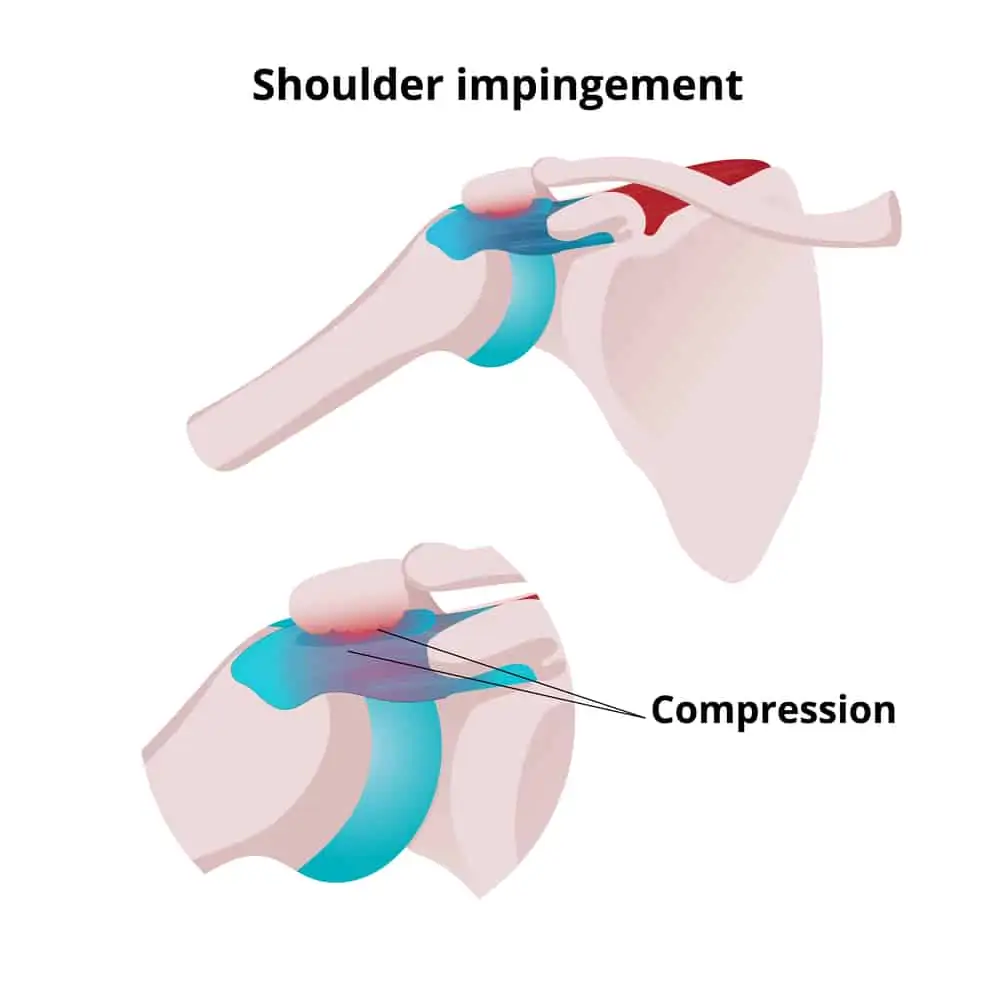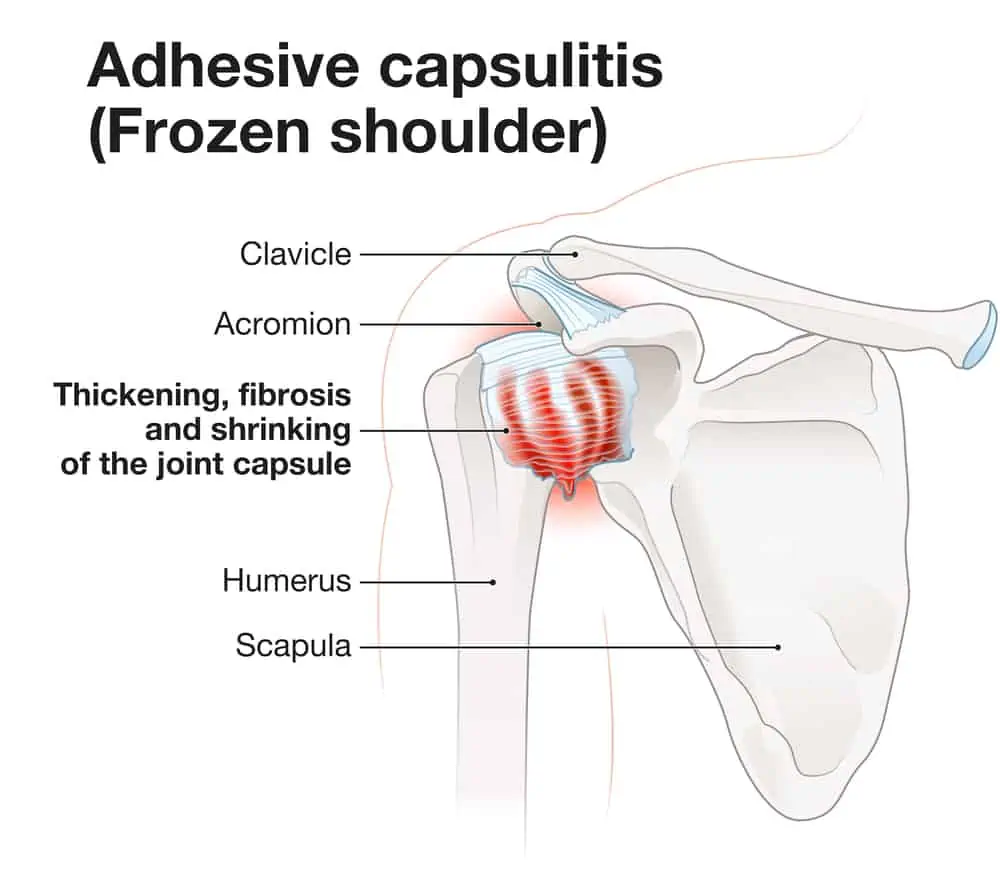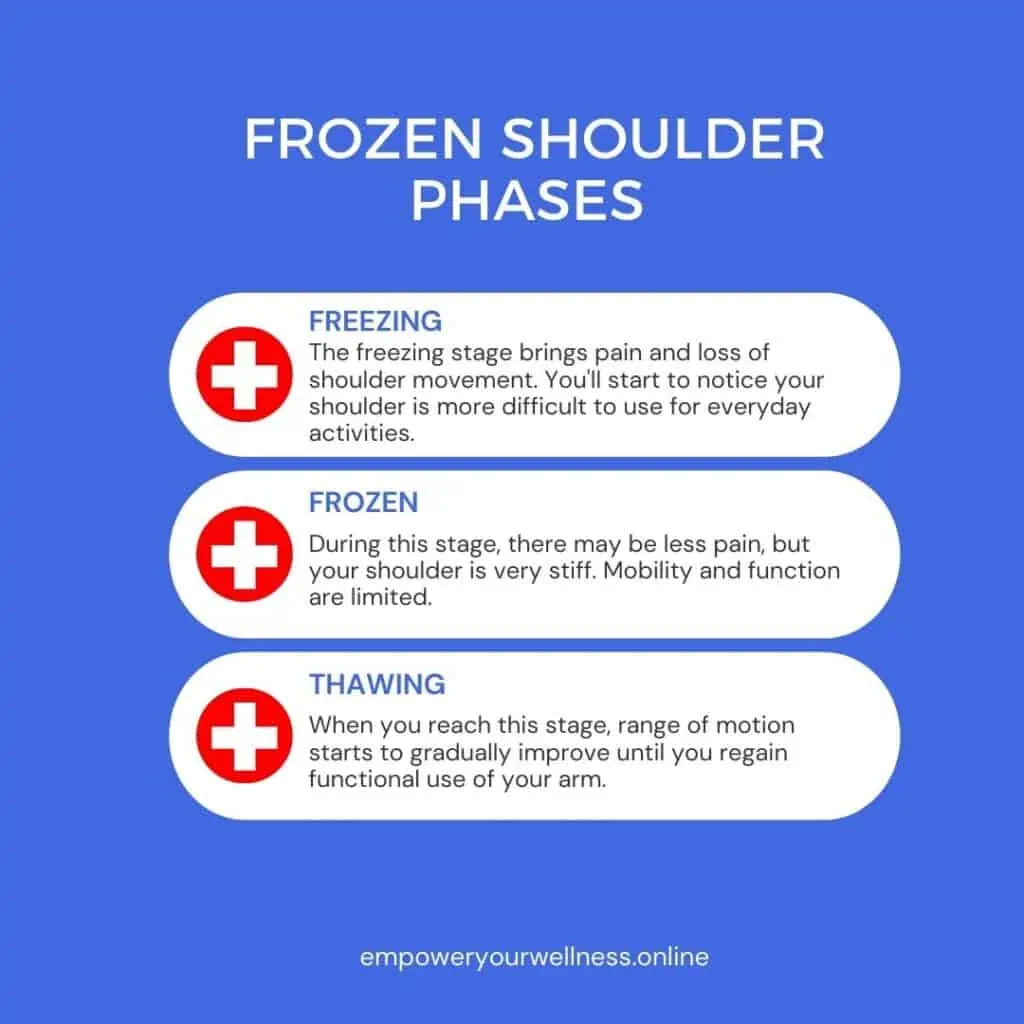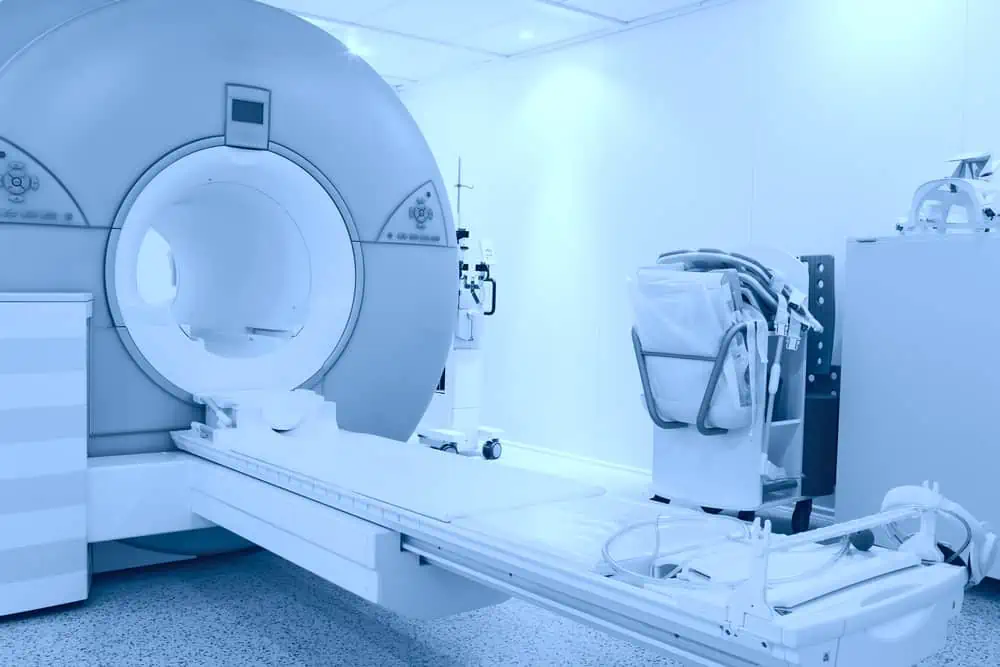This post may contain affiliate links. If you click through a link and make a purchase, I may receive a commission at no additional cost to you. As an Amazon Associate, I earn from qualifying purchases. Read the full disclosure here.
When you have shoulder pain, chances are you’ve come across many different terminologies.
As a physical therapist, I see shoulder pain quite commonly. Shoulder impingement, rotator cuff injury, frozen shoulder – what’s the difference, and what does this mean for your rehab?
This confusion can make it challenging to learn more about your condition and get the right treatments to get better fast.
In this article, I’ll quickly break down the difference between shoulder impingement vs. frozen shoulder so you can confidently move forward and know what to expect.
- What is shoulder impingement?
- Symptoms of shoulder impingement
- How long does shoulder impingement take to heal?
- Can physical therapy help shoulder impingement?
- What is frozen shoulder?
- Symptoms of frozen shoulder
- How long does frozen shoulder take to heal?
- Does physical therapy help frozen shoulder?
- Tips to help you recover faster from a shoulder injury
Disclaimer: This content is for educational purposes and is not medical advice. Read the full disclaimer.
What is shoulder impingement?
Shoulder impingement is one of the most common causes of shoulder pain.
Under normal circumstances, the shoulder joint is guided through a variety of motions with precision, thanks to the coordination of several muscles.
Shoulder impingement describes a condition in which the supraspinatus tendon (one of the rotator cuff muscles) becomes impinged (or pinched) between the top of the upper arm bone (humeral head) and the acromion of the scapula.
Shoulder anatomy is rather complex and pain can occur due to a shift in the mechanics of the shoulder from overuse, muscle strength imbalance, other injuries outside of the shoulder region, poor posture, or fatigue.

Shoulder impingement goes by a variety of names to describe the same injury. You might also hear it referred to as shoulder tendonitis, rotator cuff tendonitis, impingement syndrome, or even swimmer’s shoulder.
Impingement syndrome may manifest as a result of other conditions or injuries, including shoulder instability, shoulder bursitis, or other rotator cuff-related pain.
There may or may not also be a rotator cuff tear present.
Related read: What To Avoid When You Have Shoulder Impingement
Symptoms of shoulder impingement
- Pain in the shoulder, possibly radiating to the outer arm, shoulder blade, elbow, or wrist
- Decreased shoulder motion or painful portions of your range of motion
- Difficulty sleeping on the affected shoulder
- Decreased strength or functional use of the arm due to pain
Shoulder impingement often starts as a dull ache at the top of the shoulder with reaching overhead, to the side, or behind the back.
It can be easy to ignore at this stage, but this is one pain you shouldn’t try to work through – a big misconception with the “no pain-no gain” crowd.
In more severe cases, pain may radiate down the outside of the arm to the elbow or even the wrist. The pain may feel sharp at times, especially when moving too quickly into an aggravating range of motion.
Pain may be present in small areas of range of motion or throughout a more extensive arc and can range from mild to severe.
Shoulder impingement can progress to a frozen shoulder if not treated. As a result, some people are at an increased risk of developing frozen shoulder. (More on this later in the article.)
For plenty of tips on how to relieve rotator cuff pain at night, read this article.
How long does shoulder impingement take to heal?
The answer to this question depends on several factors, including how long you’ve had your symptoms, how severe they are, and other individual factors like occupation and your ability to modify activities.
Since I can’t take out my crystal ball, I’ll just have to say that with proper treatment, mild shoulder impingement can heal in just a few weeks. For more severe cases, it may take 8-12 weeks or possibly longer if there are other factors.
Not constantly aggravating your shoulder pain will help you heal faster. Read this article outlining in detail exercises to avoid (and why) when you have a rotator cuff injury.
Can physical therapy help shoulder impingement?
Physical therapy is an excellent conservative option for shoulder impingement pain.
Shoulder mechanics can be affected by several areas. Physical therapy can help evaluate your overall movement and mobility to restore proper joint motion, strength, and use of your shoulder.
Depending on your insurance and the state you live in, you may be able to take advantage of direct access, meaning you can be evaluated by a physical therapist before seeing your doctor.
This allows you to start getting treatment earlier and possibly heal faster by bypassing wait times for a doctor’s appointment with an orthopedist or sports medicine physician.
If you’d like to see a doctor quickly, you can always start with your primary care doctor before progressing to a shoulder specialist.
Ask your local physical therapy clinic if you’re eligible for direct access.
Read this article to learn more about how to prepare for your first physical therapy appointment and how you can download the free checklist.
What is frozen shoulder?
Is impingement syndrome the same as frozen shoulder? Not exactly.
Frozen shoulder, also known as adhesive capsulitis, is a condition characterized by pain and gradual stiffness in the shoulder capsule, followed by gradual resolution of symptoms. The entire process can take up to one year or more.
The shoulder capsule is the thick connective tissue that encapsulates the joint in a fluid-filled sac to assist with lubrication and stability of the joint.
Primary insidious onset frozen shoulder appears without any specific cause.
According to Uppal HS et al., frozen shoulder affects approximately 3-5% of individuals in the general population and up to 20% in those with diabetes.
Other conditions such as cardiovascular disease, Parkinson’s, or thyroid issues may increase the risk of developing frozen shoulder.
Frozen shoulder can also be a complication following shoulder surgery or immobilization. The joint and surrounding tissues become tight from lack of use. This is known as secondary frozen shoulder.

Symptoms of frozen shoulder
Frozen shoulder or impingement? There is some overlap between these two conditions. Shoulder impingement may or may not turn into frozen shoulder, so don’t panic.
Frozen shoulder has three phases which can be described as a freezing stage, frozen stage, and thawing stage. Each of these phases can take several months.
- Freezing stage – pain and loss of shoulder movement, you start to notice your shoulder is more difficult to use for everyday activities. It’s suggested that this initial inflammatory phase causes the joint capsule to become more fibrotic, therefore making movement more difficult.
- Frozen stage – during this stage, there may be less pain, but your shoulder is very stiff, mobility and function are limited
- Thawing stage – range of motion starts to improve until you regain functional use of your arm
External rotation, such as reaching to the passenger or rear seat of your car with your palm turned up, is typically the most limited, followed by flexion (reaching overhead) and internal rotation (reaching behind the back).
Functional use of your shoulder requires a combination of all three of these motions.
Check out the video by Bob & Brad below demonstrating the top three signs you have a frozen shoulder.

How long does frozen shoulder take to heal?
There is a wide range of healing times for frozen shoulder that depend on many factors.
For some, the entire process may only take a few months, especially if recognized and treated early.
For others, the process may take 6 months to one year. Some sources quote even longer and again, it depends on individual factors.
Not all cases of frozen shoulder require surgical treatment. Recognizing symptoms early and getting a proper diagnosis and starting treatment can help speed up recovery.
Does physical therapy help frozen shoulder?
One of the worst things you can do is avoid using your arm altogether. And unfortunately, I see this all too frequently.
Movement avoidance can make the stiffness worse and cause it to take longer to regain normal use of your shoulder. It’s recommended to continue to use your arm for daily activities as much as you can within modified ranges.
Starting physical therapy early can help maintain/improve range of motion and help lessen the limitations from frozen shoulder.
If you think you’ve lost some shoulder mobility, check out this article which explains quick and easy range of motion tests to try at home.
Tips to help you recover faster from a shoulder injury
Get evaluated
Shoulder pain can be due to a variety of causes, both inside of the shoulder or referred from other sources such as the neck.
Getting the right treatment depends on receiving a proper diagnosis.
If you’d like to see a doctor quickly, you can always start with your primary care doctor before progressing to a shoulder specialist.
You can also ask your local physical therapy clinic about direct access to physical therapy services.
Start physical therapy
In addition to anti-inflammatory medication or corticosteroid injections, physical therapy is an essential component of conservative treatment for both shoulder impingement and frozen shoulder.
Starting physical therapy early can help maintain/improve range of motion and help lessen the limitations from frozen shoulder.
If you have difficulty accessing or committing to consistent PT visits, ask your physical therapist to set you up with a home exercise program.
You can follow up with your therapist periodically in person or possibly even via virtual sessions.
Get shoulder pulleys for home
Shoulder pulleys are one of the best ways to maintain/improve your range of motion through various parts of your rehabilitation.
They are inexpensive and attach to a door frame for an easy way to perform a variety of range of motion exercises.
Be sure to discuss proper exercise techniques with your physical therapist.
Check out these pulleys on Amazon.
Do your home exercises
Think of exercises like medication, if you don’t take it, it doesn’t work. If you’re not consistent with your exercises, they won’t work.
Range of motion exercises require little to no equipment and can be easily done at home. Just make sure you understand the proper technique for each exercise.
Ask your physical therapist what tools you can use to improve your shoulder function at home.
Here are some common home exercise tools to help speed up your recovery:
You can read about these recommendations in more detail in the article How To Ease Shoulder Impingement Pain.
Understand the difference between activity modification and movement avoidance
Movement avoidance creates additional problems. One of the worst things you can do is avoid using your arm (unless you’re in a sling, which is another story).
If you continue to move in ways that aggravate your pain, by the end of the day you’ll probably have pain no matter what position you’re in. This also makes it difficult to identify pain-free positions and give your shoulder some relief.
Moving well within appropriate ranges is the key to activity modification and recovering faster.
There’s a fine line between discomfort and pain. Working within a semi-comfortable range of motion is the key to finding safe ways to move while giving the body space to heal.
If you keep aggravating your symptoms, it will take longer for them to resolve.
Try a wedge for getting good sleep
Sleeping is often one of the most painful things when you have shoulder pain. Getting a good night’s rest can help you heal faster.
If you’re having difficulty getting comfortable to sleep, try this wedge with room for your shoulder.
This MedCline shoulder relief wedge can be set up for multiple sleeping positions and has extra space to support your shoulder.
Related read: Best Sleeping Positions For Shoulder Pain
Wrapping up
Having a painful shoulder can limit your quality of life and ability to perform everyday tasks with ease.
Learning about your shoulder pain can help you navigate the medical system and recover faster.
Use these tips to help educate yourself along your rehab timeline. Feel better soon!
References
Chan HBY, Pua PY, How CH. Physical therapy in the management of frozen shoulder. Singapore Med J. 2017;58(12):685-689. doi:10.11622/smedj.2017107
Garving C, Jakob S, Bauer I, Nadjar R, Brunner UH. Impingement Syndrome of the Shoulder. Dtsch Arztebl Int. 2017;114(45):765-776. doi:10.3238/arztebl.2017.0765
Manske RC, Prohaska D. Diagnosis and management of adhesive capsulitis. Curr Rev Musculoskelet Med. 2008;1(3-4):180-189. doi:10.1007/s12178-008-9031-6
Uppal HS, Evans JP, Smith C. Frozen shoulder: A systematic review of therapeutic options. World J Orthop. 2015;6(2):263-268. Published 2015 Mar 18. doi:10.5312/wjo.v6.i2.263
Watts AR, Williams B, Kim SW, Bramwell DC, Krishnan J. Shoulder impingement syndrome: a systematic review of clinical trial participant selection criteria. Shoulder Elbow. 2017;9(1):31-41. doi:10.1177/1758573216663201






